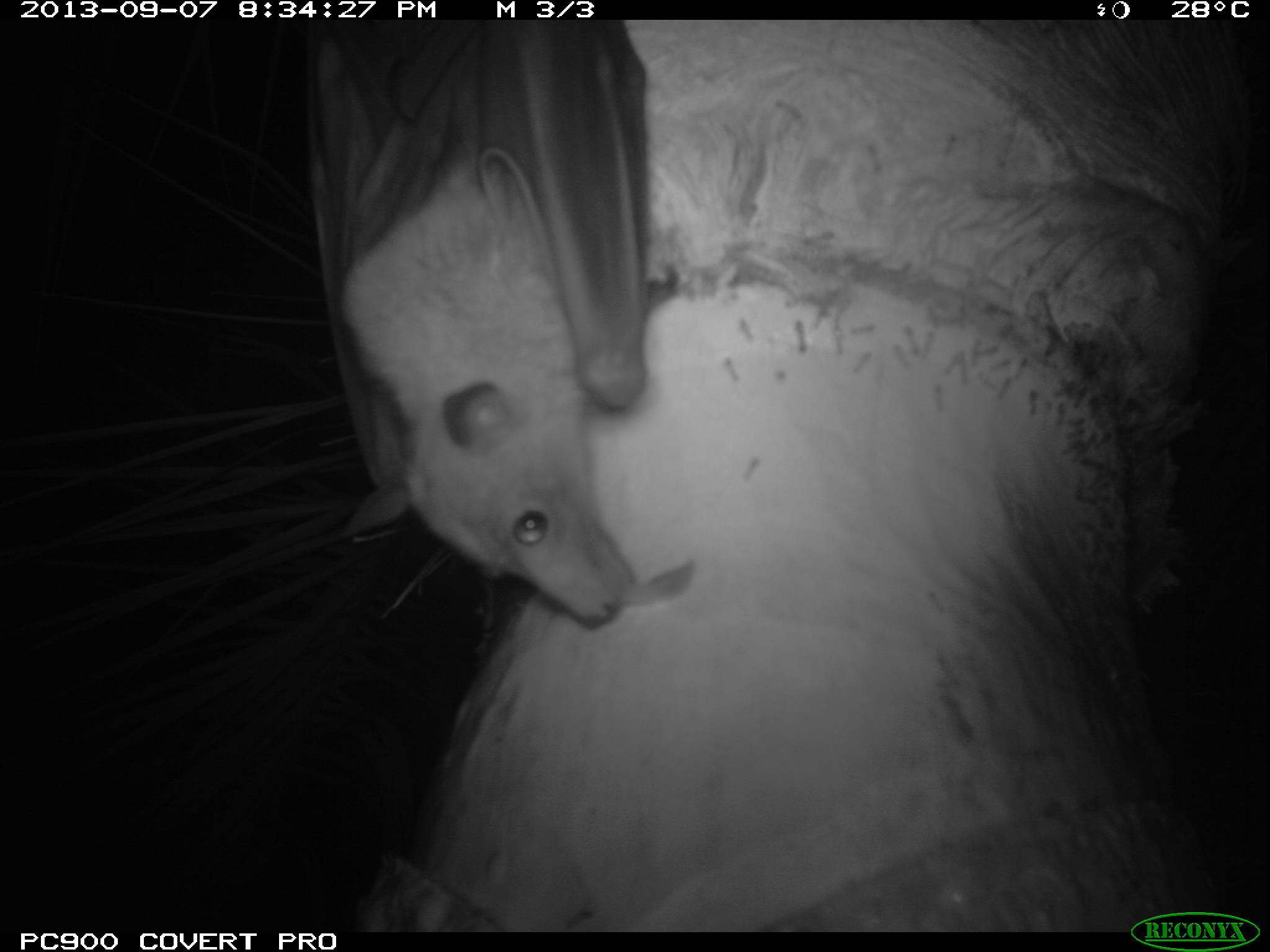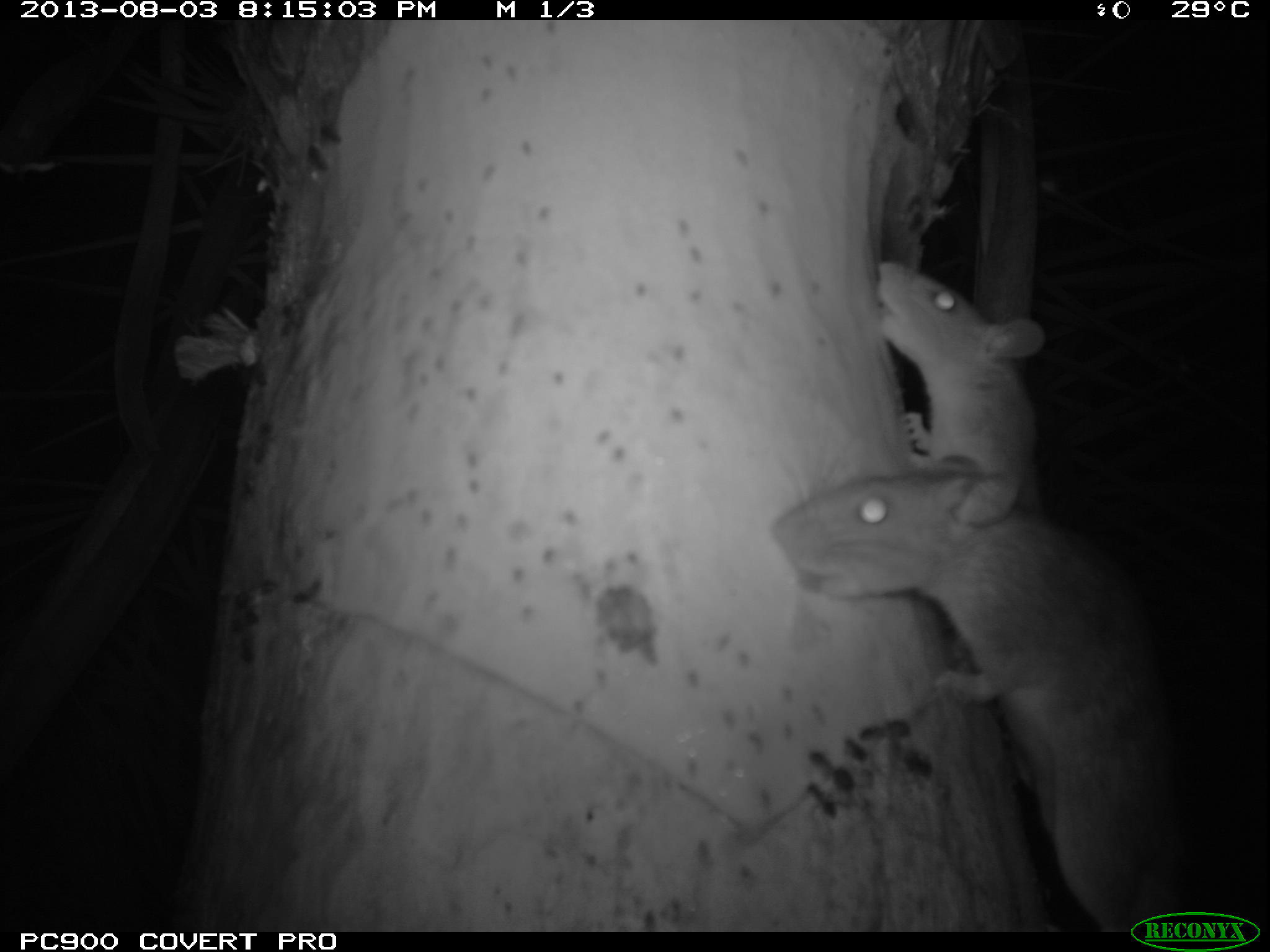|
Cycle 1 (2011 Deadline)
Defining the ecology of the Nipah virus outbreaks in Bangladesh: Identifying additional potential foodborne and livestock transmission routes PI: Muhammed Salah Uddin Khan, ICDDR US Partner: Peter Daszak, EcoHealth Alliance Inc Project dates: June 2012 - March 2016 Project Overview Nipah virus (NiV) is an emerging zoonotic virus (a virus transmitted to humans from animals) that causes high mortality in humans. In addition to human-to-human transmission, epidemiological studies have identified another possible transmission pathway, namely from fruit bats of the Pteropodidae family to humans when people drink contaminated date palm sap. Human NiV cases in Bangladesh have been found to be seasonal, coinciding with the date palm harvesting season (November to March), and consumption of date palm wine appears to serve as a major portal for infection due to contamination of palm sap from contact with urine or saliva from infected fruit bats. 
| 
| | A bat licking sap from the shaved part of a date palm tree (Photo courtesy Dr. Khan). | Two rats licking sap from the shaved part of a date palm tree( Photo courtesy Dr. Khan). |
In addition to foodborne transmission pathways, animals other than bats may play a role in transmission. The project team has previously studied livestock during outbreak investigations, and during the PEER grant, they sought to test the hypothesis that multiple species of animals (including dogs, cats, cattle, goats, horses, and pigs) may acquire and spread Nipah infection during an outbreak. The Bangladeshi and U.S. researchers developed sampling strategies and analytical approaches to assess the risk of infection via livestock and food-borne routes. This project involved screening domestic, peri-domestic, and feral animals in a NiV outbreak to look for evidence of NiV infection. Furthermore, the researchers investigated bats’ date palm sap drinking behavior year-round, in the locations where harvesters collect and ferment date palm sap for wine production. Beyond its research aspects, this project provided training in NiV surveillance, field sampling techniques, biosafety practices, and outbreak response for veterinarians under the Bangladeshi Department of Livestock Services, Ministry of Agriculture, and the Forestry Department. Final Summary of Project Activities Throughout the project, the team was able to collect a total of 1016 tree nights of observation, recording a total of 42,456 bats. The team also collected serum samples from 400 domestic (cattle, goat, horse) and 360 peri-domestic animals (rats, house shrews, cats, and dogs) from the Faridpur and Naogaon regions. Researchers were able to conduct an outbreak investigation at six different Nipah outbreak sites (Natore, Guibandha, Nauga, Rajshahi, Faridpur, Madaripur) and sampled bat roosts from those sites. All recordings and samples were reconciled to determine the seasonality of bats’ feeding behavior in relation to the seasonality of Nipah virus transmission to humans in Bangladesh. Researchers found in their study of bat date palm sap feeding behavior that Pteropus bats visited date palm trees more frequently during the spring and winter, perhaps due to lack of other available food. Feeding behavior could be one reason why the risk of Nipah infection to people has been concentrated in the winter season, even when fermented sap is consumed year-round. The researchers suggested that sap harvesters should regularly use skirts to prevent bats from contaminating the date palm sap to prevent Nipah virus and other bat associated zoonoses. They have published their findings in major international journals, with these research outputs continuing even several years after the PEER project ended. PublicationsAusraful Islam, Deborah L. Cannon, Mohammed Ziaur Rahman, Salah Uddin Khan, Jonathan H. Epstein, Peter Daszak, Stephen P. Luby, Joel M. Montgomery, John D. Klena, Emily S. Gurley. 2023. Nipah Virus Exposure in Domestic and Peridomestic Animals Living in Human Outbreak Sites, Bangladesh, 2013–2015. Emerging Infectious Diseases 29(2): 393-396. https://doi.org/10.3201/eid2902.221379 Clifton D. McKee, Ausraful Islam, Mohammed Ziaur Rahman, Salah Uddin Khan, Mahmudur Rahman, Syed M. Satter, Ariful Islam, Claude Kwe Yinda, Jonathan H. Epstein, Peter Daszak, Vincent J. Munster, Peter J. Hudson, Raina K. Plowright, Stephen P. Luby, Emily S. Gurley. 2022. Nipah Virus Detection at Bat Roosts after Spillover Events, Bangladesh, 2012–2019. Emerging Infectious Diseases 28(7): 1384-1392. https://doi.org/10.3201/eid2807.212614 Jonathan H. Epstein, Simon J. Anthony, Ariful Islam, A. Marm Kilpatrick, Shahneaz Ali Khan, Maria D. Balkey, Noam Ross, Ina Smith, Carlos Zambrana-Torrelio, Yun Tao, Ausraful Islam, Phenix Lan Quan, Kevin J. Olival, M. Salah Uddin Khan, Emily S. Gurley, M. Jahangir Hossein, Hume E. Field, Mark D. Fielder, Thomas Briese, Mahmudur Rahman, Christopher C. Broder, Gary Crameri, Lin-Fa Wang, Stephen P. Luby, W. Ian Lipkin, and Peter Daszak. 2020. Nipah virus dynamics in bats and implications for spillover to humans. Proceedings of the National Academy of Sciences 117(46): 29190–29201. https://www.pnas.org/cgi/doi/10.1073/pnas.2000429117 |
|
|
|





